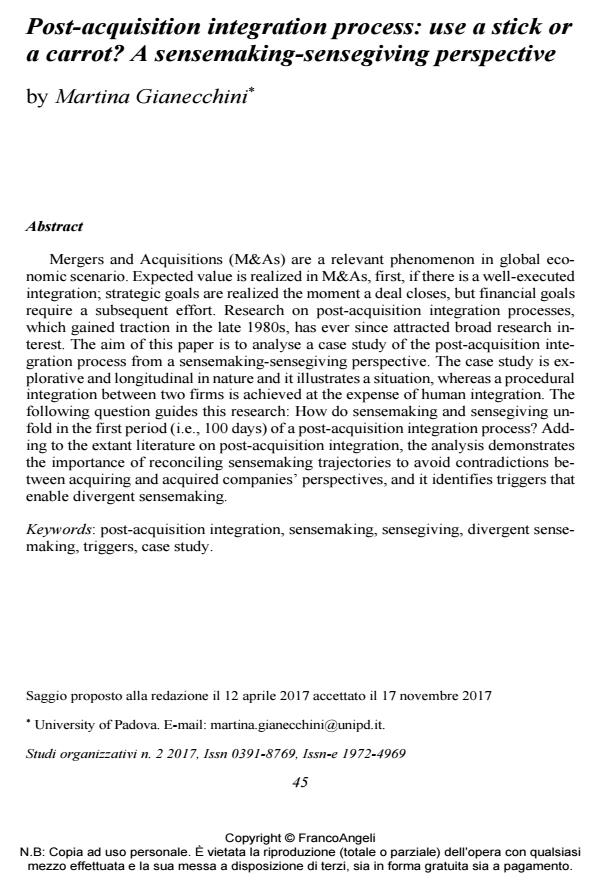Post-acquisition integration process: use a stick or a carrot? A sensemaking-sensegiving perspective
Titolo Rivista STUDI ORGANIZZATIVI
Autori/Curatori Martina Gianecchini
Anno di pubblicazione 2018 Fascicolo 2017/2
Lingua Inglese Numero pagine 23 P. 45-67 Dimensione file 258 KB
DOI 10.3280/SO2017-002003
Il DOI è il codice a barre della proprietà intellettuale: per saperne di più
clicca qui
Qui sotto puoi vedere in anteprima la prima pagina di questo articolo.
Se questo articolo ti interessa, lo puoi acquistare (e scaricare in formato pdf) seguendo le facili indicazioni per acquistare il download credit. Acquista Download Credits per scaricare questo Articolo in formato PDF

FrancoAngeli è membro della Publishers International Linking Association, Inc (PILA)associazione indipendente e non profit per facilitare (attraverso i servizi tecnologici implementati da CrossRef.org) l’accesso degli studiosi ai contenuti digitali nelle pubblicazioni professionali e scientifiche
Mergers and Acquisitions (M&As) are a relevant phenomenon in global eco-nomic scenario. Expected value is realized in M&As, first, if there is a well-executed integration; strategic goals are realized the moment a deal closes, but fi-nancial goals require a subsequent effort. Research on post-acquisition integration processes, which gained traction in the late 1980s, has ever since attracted broad research interest. The aim of this paper is to analyse a case study of the post-acquisition integration process from a sensemaking-sensegiving perspective. The case study is explorative and longitudinal in nature and it illustrates a situation, whereas a procedural integration between two firms is achieved at the expense of human integration. The following question guides this research: How do sense-making and sensegiving unfold in the first period (i.e., 100 days) of a post-acquisition integration process? Adding to the extant literature on post-acquisition integration, the analysis demonstrates the importance of reconciling sensemaking trajectories to avoid contradictions between acquiring and acquired companies’ perspectives, and it identifies triggers that enable divergent sensemaking.
Le operazioni di Fusione e Acquisizione (Merger & Acquisition) sono un fenomeno rilevante nello scenario economico globale. Numerosi però sono i casi di fallimento spesso imputati a una mancata integrazione organizzativa seguente all’operazione. Il presente studio applica una prospettiva cognitivista (sensemaking-sensegiving) al processo di integrazione che ha seguito il processo di acquisizione di un’azienda italiana da parte di una multinazionale americana. Questa integrazione, che si può definire di successo da un punto di vista operativo di integrazione tra procedure, ha mostrato però alcune difficoltà nell’integrazione tra le persone delle due aziende. Attraverso la prospettiva cognitivista è stato possibile evidenziare come queste difficoltà siano collegate a una diversa interpretazione (divergent sensemaking) dei reciproci comportamenti e azioni (sensegiving). Questa diversità di interpretazione è stata inizialmente originata da una scarsa e poco efficace comunicazione del piano di integrazione da parte della multinazionale americana e successivamente dall’utilizzo di alcune tradizionali strategie di supporto, che sono state intese in maniera opposta dagli attori coinvolti. L’analisi presentata contribuisce alla letteratura sull’integrazione post-acquisizione che si è concentrata sugli strumenti e gli effetti del processo, ma raramente sul suo svolgimento.
Parole chiave:Cambiamento organizzativo, post-acquisizioni, sensemaking, resistenza al cambiamento.
Martina Gianecchini, Post-acquisition integration process: use a stick or a carrot? A sensemaking-sensegiving perspective in "STUDI ORGANIZZATIVI " 2/2017, pp 45-67, DOI: 10.3280/SO2017-002003